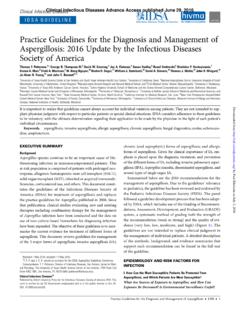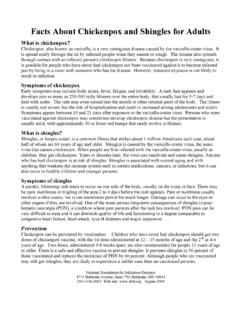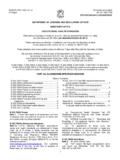Transcription of Summary Infectious History - Columbia University
1 Science -- Lederberg 288 (5464): 287. Institution: Columbia University | Sign In as Individual | FAQ | Access Rights | Join AAAS. Summary of this Article Infectious History dEbates: Submit a response to this article Joshua Lederberg*. Related commentary and In 1530, to express his ideas on the origin of syphilis, the Italian articles in Science physician Girolamo Fracastoro penned Syphilis, sive morbus products Gallicus (Syphilis, or the French disease) in verse. In it he taught that this sexually transmitted disease was spread by "seeds". Download to Citation distributed by intimate contact. In later writings, he expanded this Manager early "contagionist" theory. Besides contagion by personal contact, he described contagion by indirect contact, such as the handling or Alert me when: wearing of clothes, and even contagion at a distance, that is, the new articles cite this article spread of disease by something in the air.
2 Search for similar articles in: Fracastoro was anticipating, by nearly 350 years, one of the most Science Online important turning points in biological and medical History --the ISI Web of Science consolidation of the germ theory of disease by Louis Pasteur and PubMed Robert Koch in the late 1870s. As we enter the 21st century, Search Medline for articles Infectious disease is fated to remain a crucial research challenge, by: one of conceptual intricacy and of global consequence. Lederberg, J. Search for citing articles in: The Incubation of a Scientific Discipline ISI Web of Science (15). Many people laid the groundwork for the germ theory. Even the HighWire Press Journals terrified masses touched by the Black Death (bubonic plague) in Europe after 1346 had some intimation of a contagion at work.
3 But This article appears in the they lived within a cognitive framework in which scapegoating, following Subject Collections: say, of witches and Jews, could more "naturally" account for their Microbiology woes. Breaking that mindset would take many innovations, Immunology including microscopy in the hands of Anton van Leeuwenhoek. In 1683, with one of his new microscopes in hand, he visualized bacteria among the animalcules harvested from his own teeth. That opened the way to visualize some of the dreaded microbial agents eliciting contagious diseases. (1 of 18) [9/2/2003 3:43:11 PM]. Science -- Lederberg 288 (5464): 287. There were pre-germ-theory advances in therapy, too. Jesuit missionaries in malaria-ridden Peru had noted the native Indians' use of Cinchona bark. In 1627, the Jesuits imported the bark (harboring quinine, its anti- infective ingredient) to Europe for treating malaria.
4 Quinine thereby joined the rarified pharmacopoeia-- including opium, digitalis, willow (Salix) bark with its analgesic salicylates, and little else--that prior to the modern era afforded patients any benefit beyond placebo. Beginning in 1796, Edward Jenner took another major therapeutic step--the development of vaccination-- after observing that milkmaids exposed to cowpox didn't contract smallpox. He had no theoretical insight into the biological mechanism of resistance to the disease, but vaccination became a lasting prophylactic technique on purely empirical grounds. Jenner's discovery had precursors. "Hair of the dog" is an ancient trope for countering injury and may go back to legends of the emperor Mithridates, who habituated himself to lethal doses of poisons by gradually increasing the dose.
5 We now understand more about a host's immunological response to a cross-reacting virus variant. Sanitary reforms also helped. Arising out of revulsion over the squalor and stink of urban slums in England and the United States, a hygienic movement tried to scrub up dirt and put an end to sewer stenches. The effort had some health impact in the mid-19th century, but it failed to counter diseases spread by fleas and mosquitoes or by personal contact, and it often even failed to keep sewage and drinking water supplies separated. It was the germ theory--which is credited to Pasteur (a chemist by training) and Koch (ultimately a German professor of public health)--that set a new course for studying and contending with Infectious disease. Over the second half of the 19th century, these scientists independently synthesized historical evidence with their own research into the germ theory of disease.
6 Pasteur helped reveal the vastness of the microbial world and its many practical applications. He found microbes to be behind the fermentation of sugar into alcohol and the souring of milk. He developed a heat treatment (pasteurization, that is) that killed microorganisms in milk, which then no longer transmitted tuberculosis or typhoid. And he too developed new vaccines. One was a veterinary vaccine against anthrax. Another was against rabies and was first used in humans in 1885 to treat a young boy who had been bitten by a rabid dog. One of Koch's most important advances was procedural. He articulated a set of logical and experimental criteria, later restated as "Koch's Postulates," as a standard of proof for researchers' assertions that a particular bacterium caused a particular malady.
7 In 1882, he identified the bacterium that causes tuberculosis; a year later he did the same for cholera. Koch also left a legacy of students (and rivals) who began the systematic search for disease-causing microbes: The golden age of microbiology had begun. Just as the 19th century was ending, the growing world of microbes mushroomed beyond bacteria. In 1892, the Russian microbiologist Dmitri Ivanowski, and in 1898, the Dutch botanist Martinus Beijerinck, discovered exquisitely tiny Infectious agents that could pass through bacteria-stopping filters. Too small to be seen with the conventional microscope, these agents were described as "filtrable [sic] viruses.". (2 of 18) [9/2/2003 3:43:11 PM]. Science -- Lederberg 288 (5464): 287. With a foundation of germ theory in place even before the 20th century, the study of Infectious disease was ready to enter a new phase.
8 Microbe hunting became institutionalized, and armies of researchers systematically applied scientific analyses to understanding disease processes and developing therapies. During the early acme of microbe hunting, from about 1880 to 1940, however, microbes were all but ignored by mainstream biologists. Medical microbiology had a life of its own, but it was almost totally divorced from general biological studies. Pasteur and Koch were scarcely mentioned by the founders of cell biology and genetics. Instead, bacteriology was taught as a specialty in medicine, outside the schools of basic zoology and botany. Conversely, bacteriologists scarcely heard of the conceptual revolutions in genetic and evolutionary theory. Bacteriology's slow acceptance was partly due to the minuscule dimensions of microbes.
9 The microscopes of the 19th and early 20th centuries could not resolve internal microbial anatomy with any detail. Only with the advent of electron microscopy in the 1930s did these structures (nucleoids, ribosomes, cell walls and membranes, flagella) become discernible. Prior to that instrumental breakthrough, most biologists had little, if anything, to do with bacteria and viruses. When they did, they viewed such organisms as mysteriously precellular. It was still an audacious leap for Ren Dubos to entitle his famous 1945. monograph "The Bacterial Cell.". The early segregation of bacteriology and biology per se hampered the scientific community in recognizing the prospects of conducting genetic investigation with bacteria. So it is ironic that the pivotal discovery of molecular genetics--that genetic information resides in the nucleotide sequence of DNA-- arose from studies on serological types of pneumococcus, studies needed to monitor the epidemic spread of pneumonia.
10 This key discovery was initiated in 1928 by the British physician Frederick Griffith. He found that extracts of a pathogenic strain of pneumococcus could transform a harmless strain into a pathogenic one. The hunt was then on to identify the "transforming factor" in the extracts. In 1944, Oswald Avery, Colin MacLeod, and Maclyn McCarty reported in the Journal of Experimental Medicine that DNA was the transforming factor. Within a few years, they and others ruled out skeptics' objections that protein coextracted with the DNA might actually be the transforming factor. Those findings rekindled interest in what was really going on in the life cycle of bacteria. In particular, they led to my own work in 1946 on sexual conjugation in Escherichia coli and to the construction of chromosome maps emulating what had been going on in the study of the genetics of fruit flies, maize, and mice for the prior 45 years.

















